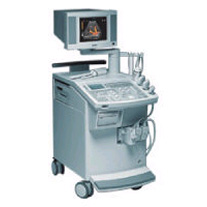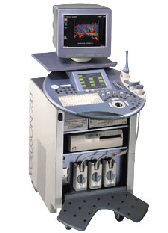Medical Ultrasound Imaging
Sunday, 19 May 2024
'Archiving' p2 Searchterm 'Archiving' found in 10 articles 1 term [ • ] - 9 definitions [• ] Result Pages : •  From Siemens Medical Systems;
From Siemens Medical Systems;'This extremely flexible system supports targeted applications for OB/GYN, Radiology, Internal Medicine, Urology, and Prostate Brachytherapy. The large transducer selection, most with high-frequency capabilities, provides the right tool for general imaging, radiology, and internal medicine applications.'
Device Information and Specification
CLINICAL APPLICATION
OB/GYN, cerebrovascular, orthopedics, urology, peripheral vascular, pediatrics, small parts, surgery, abdominal, musculoskeletal
CONFIGURATION
Mobile, compact
DISPLAY MODES
Broadband, high-fidelity, multi-frequency, linear and curved
PROBE PORTS
Two - four
256
MEASUREMENT/CALCULATION FUNCTIONS
OB/GYN measurements and report package, off-line analysis
OPTIONAL PACKAGE
IMAGE PROCESSING
•
Common ultrasound supplies that are often used in conjunction with ultrasound imaging:
•
Ultrasound Gel: A water-based gel used as a coupling agent between the transducer and the patient's skin. It helps eliminate air pockets and ensures good sound wave transmission. •
Probe Covers: Disposable covers designed to maintain hygiene and prevent cross-contamination. These covers are placed over the transducer before each examination. •
Cleaning Wipes: Alcohol-based or disinfectant wipes used for cleaning and disinfecting the transducer and other equipment surfaces. Specific cleaning solutions are recommended by the ultrasound equipment manufacturer for thorough cleaning of transducers. •
Gel Warmers: Devices used to warm ultrasound gel, providing patient comfort during the examination. •
Needle Guides: Attachments or brackets that assist in accurate needle placement during ultrasound-guided procedures such as biopsies or injections. •
Positioning Aids: Cushions, wedges, or straps designed to help position patients correctly and comfortably during ultrasound exams. Common ultrasound accessories that are often used in conjunction with ultrasound imaging: •
Transducer Storage Rack: A dedicated rack or holder to store transducers safely when not in use, helping to prevent damage. •
Storage and Archiving Solutions: External hard drives, network storage, or cloud-based systems for long-term storage and backup of ultrasound images and reports. Possibly specialized printers that produce hard copies of ultrasound images for immediate documentation and patient records. •
Power Supply and Transducer Cable Extenders: Extension cables used to increase the length of transducer cables for more flexibility during examinations. Adequate power sources or uninterrupted power supply (UPS) to ensure continuous operation of the ultrasound machine during power outages or fluctuations. •
Reporting Templates and Software: Customizable reporting templates and software solutions that facilitate efficient and standardized reporting of ultrasound findings. •
Phantom Devices: Artificial tissue-like structures or phantoms used for training, calibration, and quality assurance purposes to evaluate image quality and system performance. Consult with ultrasound equipment vendors or professionals in the field to determine the specific accessories and supplies that best suit your imaging needs and specialty. See also Equipment Preparation, Environmental Protection, Portable Ultrasound Machine, Ultrasound Technology, Ultrasound System Performance and Sonographer. •
The ultrasound equipment includes the ultrasound machine, the coaxial cable, the transducer assembly, different modalities to print out and store the ultrasound pictures, ultrasound gel, and a couch for the patients. Often, the ultrasound system is connected with the internal radiology information system which allows the takeover of patient data, and a picture archiving and communication system to store images. See also Ultrasound System Performance. •
Ultrasound machines, widely used in medical imaging, are essential tools in the field of diagnostic ultrasound. These devices utilize high-frequency sound waves to create real-time images of internal body structures. Ultrasound machines consist of several key components that work together to generate diagnostic images.
These include:
•
The transducer is a handheld device that emits and receives sound waves. It converts electrical energy into sound waves and captures the returning echoes to create images.
•
The control panel houses the interface where the sonographer adjusts imaging parameters such as depth, frequency, and gain. It allows for customization of imaging settings based on the clinical requirements. The transducer pulse controls change the amplitude, frequency and duration of the pulses emitted from the transducer probe.
•
The central processing unit (CPU) serves as the brain of the ultrasound machine, processing the acquired data and transforming it into images. It handles complex calculations, image optimization, data storage and contains the electrical power supplies for itself and the transducer probe.
•
The display monitor (oscilloscope, tablet, computer monitor, etc.) showcases the real-time ultrasound images produced by the machine. It provides visual feedback to the sonographer, aiding in the interpretation and analysis of anatomical structures. Handheld ultrasound devices and mobile ultrasound probes can be connected wirelessly to a smartphone or tablet via Bluetooth or WiFi. These end device serves then as the ultrasound monitor.
•
Data input and measurements are done with the keyboard cursor (trackball). Ultrasound devices used for handheld point of care ultrasound (HPOCUS) are operated via the touch screen of the control panel.
•
Images are captured, reviewed, stored and transmitted digitally, using a standard format for digital imaging and communications in medicine (DICOM). Disk storage devices (FDD, HDD, CD, DVD) are outdated, but may be used in older machines to store the acquired images if no picture archiving and communication system (PACS) connection is possible.
•
The displayed ultrasound pictures are usually digitally stored in a PACS. The images from portable ultrasound machines can be stored and conveniently managed on the end device itself, the inserted memory card or in the cloud. With a QR scanner, the images can be accessed via the Internet in the cloud. Often there is also the possibility to get a picture of a baby sonography as a printout.
B-mode machines represent the vast majority of machines used in echocardiology, obstetrical scans, abdominal scans, gynecological scans, etc. B-mode ultrasound machines usually produce the sector (or pie segment-shaped) scans. These ultrasound scans require either a mechanical scanner transducer (the transducer moves to produce the sector scan), or a linear array transducer operated as a phased array. Ultrasound machines come in different types, each catering to specific clinical needs. The two primary types are stationary and portable ultrasound machines: •
Stationary units are typically larger in size and are installed in dedicated imaging rooms. These machines offer advanced imaging capabilities and a wide range of specialized features. They are commonly found in hospitals, clinics, and university medical centers where comprehensive imaging services are provided.
•
Portable units (see Portable Ultrasound Machine), as the name suggests, are compact and lightweight, designed for on-the-go imaging. These machines are highly versatile and offer excellent mobility, allowing healthcare professionals to bring the ultrasound system directly to the patient's bedside. Portable ultrasound machines are particularly useful in emergency settings, rural healthcare facilities, and point-of-care applications.
See also Handheld Ultrasound, Ultrasound System Performance, Equipment Preparation, Coaxial Cable, and Microbubble Scanner Modification, Environmental Protection and Ultrasound Accessories and Supplies. Further Reading: Basics: News & More:
•  From GE Healthcare.;
From GE Healthcare.;'GE is defining a new age of ultrasound. We call it Volume Ultrasound. GE's Voluson 730 Expert is a powerful system that enables real-time techniques for acquiring, navigating and analyzing volumetric images so that you can make clinical decisions with unprecedented confidence.'
Device Information and Specification
APPLICATIONS
Abdominal, breast, cardiac, musculoskeletal, neonatal, OB/GYN, pediatric, small parts, transcranial, urological, vascular
CONFIGURATION
15' high resolution non-interlaced flat CRT, 4 active probe ports
B-mode, M-mode, coded harmonic imaging (2-D), color flow mode (CFM), power Doppler imaging (PDI), color Doppler, pulsed wave Doppler, high pulse repetition frequency (HPRF) Doppler, tissue harmonic imaging, 3-D power Doppler
IMAGING OPTIONS
CrossXBeam spatial compounding, coded excitation , spatio-temporal image correlation (STIC), B-Flow (simultaneous imaging of tissue and blood flow), strain rate imaging (SRI)
OPTIONAL PACKAGE
STORAGE, CONNECTIVITY, OS
SonoView archiving and data management, network, HDD, DICOM 3.0, CD/DVD, MOD, USB, Windows-based
DATA PROCESSING
Digital beamformer with 512 system processing channel technology
H*W*D m (inch.)
1.43 * 0.69 * 1.02 (56 * 27 * 40)
WEIGHT
136 kg (300 lbs.)
Result Pages : |
Medical-Ultrasound-Imaging.com
former US-TIP.com
Member of SoftWays' Medical Imaging Group - MR-TIP • Radiology TIP • Medical-Ultrasound-Imaging
Copyright © 2008 - 2024 SoftWays. All rights reserved.
Terms of Use | Privacy Policy | Advertise With Us
former US-TIP.com
Member of SoftWays' Medical Imaging Group - MR-TIP • Radiology TIP • Medical-Ultrasound-Imaging
Copyright © 2008 - 2024 SoftWays. All rights reserved.
Terms of Use | Privacy Policy | Advertise With Us
[last update: 2023-11-06 01:42:00]




